Sizing Up Servers: Intel's Skylake-SP Xeon versus AMD's EPYC 7000 - The Server CPU Battle of the Decade?
by Johan De Gelas & Ian Cutress on July 11, 2017 12:15 PM EST- Posted in
- CPUs
- AMD
- Intel
- Xeon
- Enterprise
- Skylake
- Zen
- Naples
- Skylake-SP
- EPYC
Intel Expanding the Chipset: 10 Gigabit Ethernet and QuickAssist Technology
The refresh strategy from Intel on the chipset side has an ultra-long cadence. In recent memory, Intel’s platform launches are designed to support two generations of processor release, and in that time there is typically no chipset update, leaving the platform controller hub semi-static for functionality for usually three years. This is compared to the consumer side, where new chipsets are launched with every new CPU generation, with bigger jumps coming every couple of years. For the new launch today, Intel pushing the enterprise chipset ahead in a new direction.
The point of the chipset previously was to provide some basic IO support in the form of SATA/SAS ports, some USB ports, and a few PCIe lanes for simple controllers like USB 3.0, Gigabit Ethernet, or perhaps an x4 PCIe slot for a non-accelerator type card. The new chipsets, part of the C620 family codenamed Lewisburg, are designed to assist with networking, cryptography, and act more like a PCIe switch with up to 20 PCIe 3.0 lane support.
The headline features that matter most is the upgrade in DMI connection to the chipset, upgraded from DMI 2.0 to DMI 3.0 to match the consumer platforms, having those 20 PCIe 3.0 lanes from the chipset, and also the new feature under CPU Uplink.
For the new generation of Lewisburg chipsets, if an OEM requires that a platform has access to a cryptography engine or 10 Gigabit Ethernet, then they can attach 8 or 16 lanes from the processor into the chipset via this CPU Uplink port. Depending on which model of chipset is being used, this can provide up to four 10 GbE ports with iWARP RDMA, or up to 100 GB/s IPSec/SSL of QuickAssist support.
Intel will offer seven different versions of the chipset, varying in 10G and QAT support, but also varying in TDP:
On the cryptography side, Intel has previously sold add-in PCIe cards for QuickAssist, but is now moving it onto the systems directly. By adding it into the chipset, it can be paired with the Ethernet traffic and done in-situ, and specifically Intel points to bulk cryptography (150 Gb/s AES256/SHA256), Public Key Encryption (100k ops of RSA2048) and compression (100+ Gb/s deflate).
With the GbE, Intel has designed this to be paired with the X722 PHY, and supports network virtualization, traffic shaping, and supports Intel’s Data Plane Development Kit for advanced packet forwarding.
The chipset will also include a new feature called Intel’s Innovation Engine, giving a small embedded core into the PCH which mirrors Intel’s Management Engine but is designed for system-builders and integrators. This allows specialist firmware to manage some of the capabilities of the system on top of Intel’s ME, and is essentially an Intel Quark x86 core with 1.4MB SRAM.
The chipsets are also designed to be supported between different CPUs within the same multi-processor system, or for a system to support multiple chipsets at once as needed.


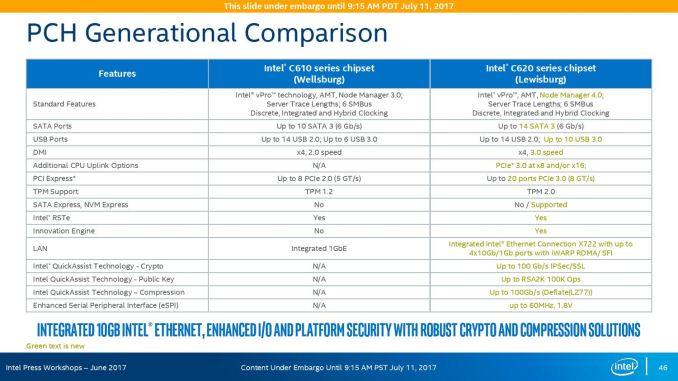
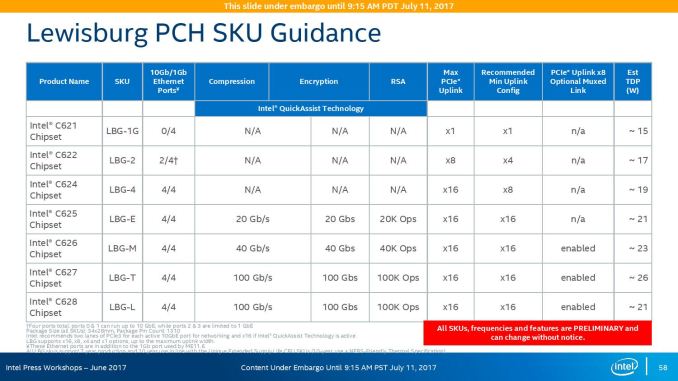
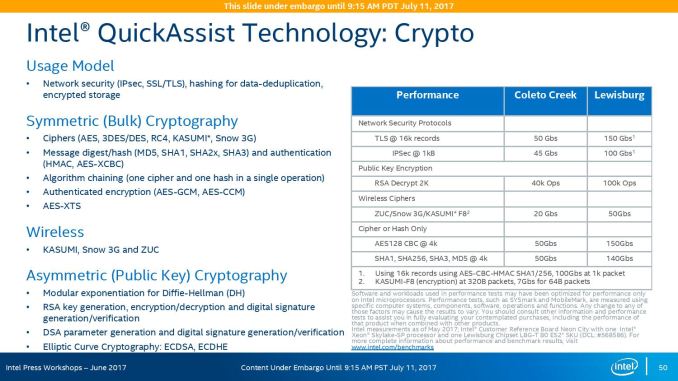

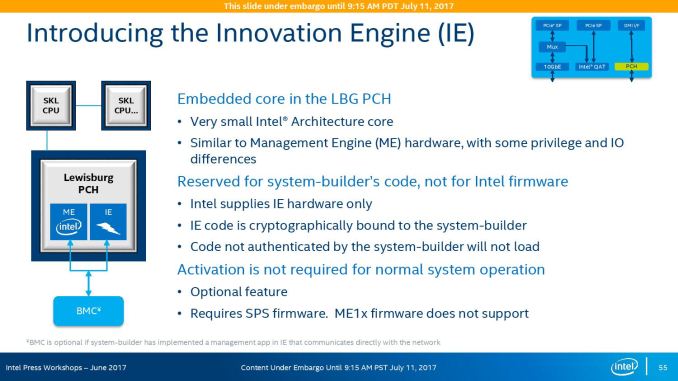
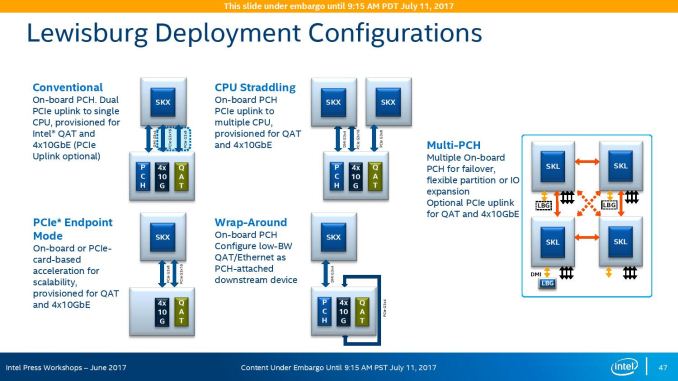








219 Comments
View All Comments
JKflipflop98 - Wednesday, July 12, 2017 - link
For years I thought you were just really committed to playing the "dumb AMD fanbot" schtick for laughs. It's infinitely more funny now that I know you've actually been *serious* this entire time.ddriver - Wednesday, July 12, 2017 - link
Whatever helps you feel better about yourself ;) I bet it is funny now, that AT have to carefully devise intel biased benches and lie in its reviews in hopes intel at least saves face. BTW I don't have a single amd CPU running ATM.WinterCharm - Thursday, July 13, 2017 - link
Uh, what are you smoking? this is a pretty even piece.boozed - Tuesday, July 11, 2017 - link
You haven't done your job properly unless you've annoyed the fanboys (and perhaps even fangirls) for both sides!JohanAnandtech - Wednesday, July 12, 2017 - link
Wise words. Indeed :-)Ranger1065 - Wednesday, July 12, 2017 - link
If you are referring to ddriver, I agree, wise words indeed.ddriver - Wednesday, July 12, 2017 - link
Well, that assumption rests on the presumption that the point of reviews is to upsed fanboys.I'd say that a "review done right" would include different workload scenarios, there is nothing wrong with having one that will show the benefits of intel's approach to doing server chips, but that should be properly denoted, and should be just one of several database tests and should be accompanied by gigabytes of databases which is what we use in real world scenarios.
CoachAub - Wednesday, July 12, 2017 - link
It was mentioned more than once that this review was rushed to make a deadline and that the suite of benchmarks were not everything they wanted to run and without optimizations or even the usual tweaks an end-user would make to their system. So, keep that in mind as you argue over the tests and different scenarios, etc.ddriver - Thursday, July 13, 2017 - link
It doesn't take a lot of time to populate a larger database so that you can make a benchmark that involves an actual real world usage scenario. It wasn't the "rushing" that prompted the choice of database size...mpbello - Friday, July 14, 2017 - link
If you are rushing, you reduce scope and deliver fewer pieces with high quality instead of insisting on delivering a full set of benchmarks that you are not sure about its quality.The article came to a very strong conclusion: Intel is better for database scenarios. Whatever you do, whether you are rushing or not, you cannot state something like that if the benchmarks supporting your conclusion are not well designed.
So I agree that the design of the DB benchmark was incredibly weak to sustain such an important conclusion that Intel is the best choice for DB applications.